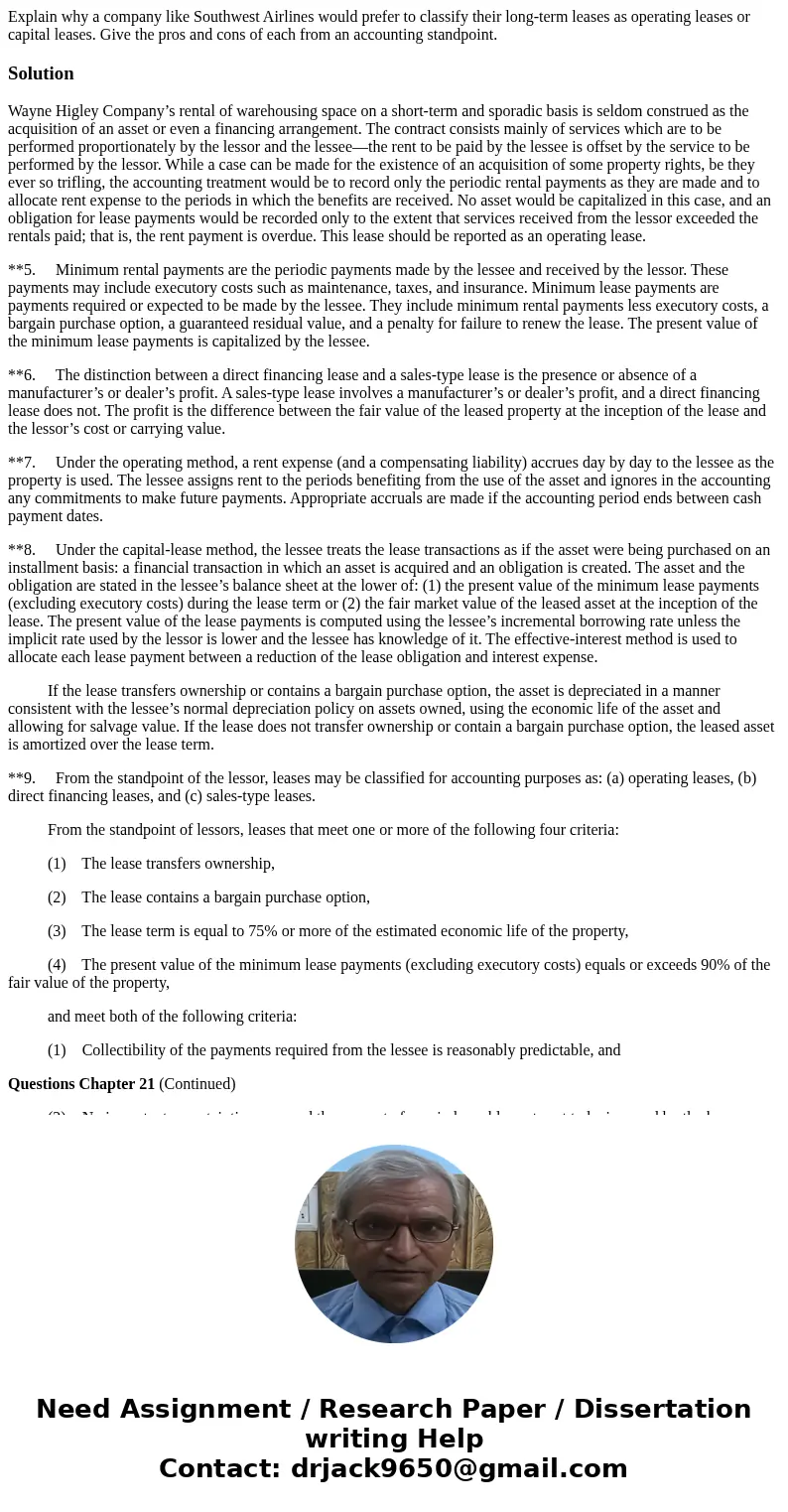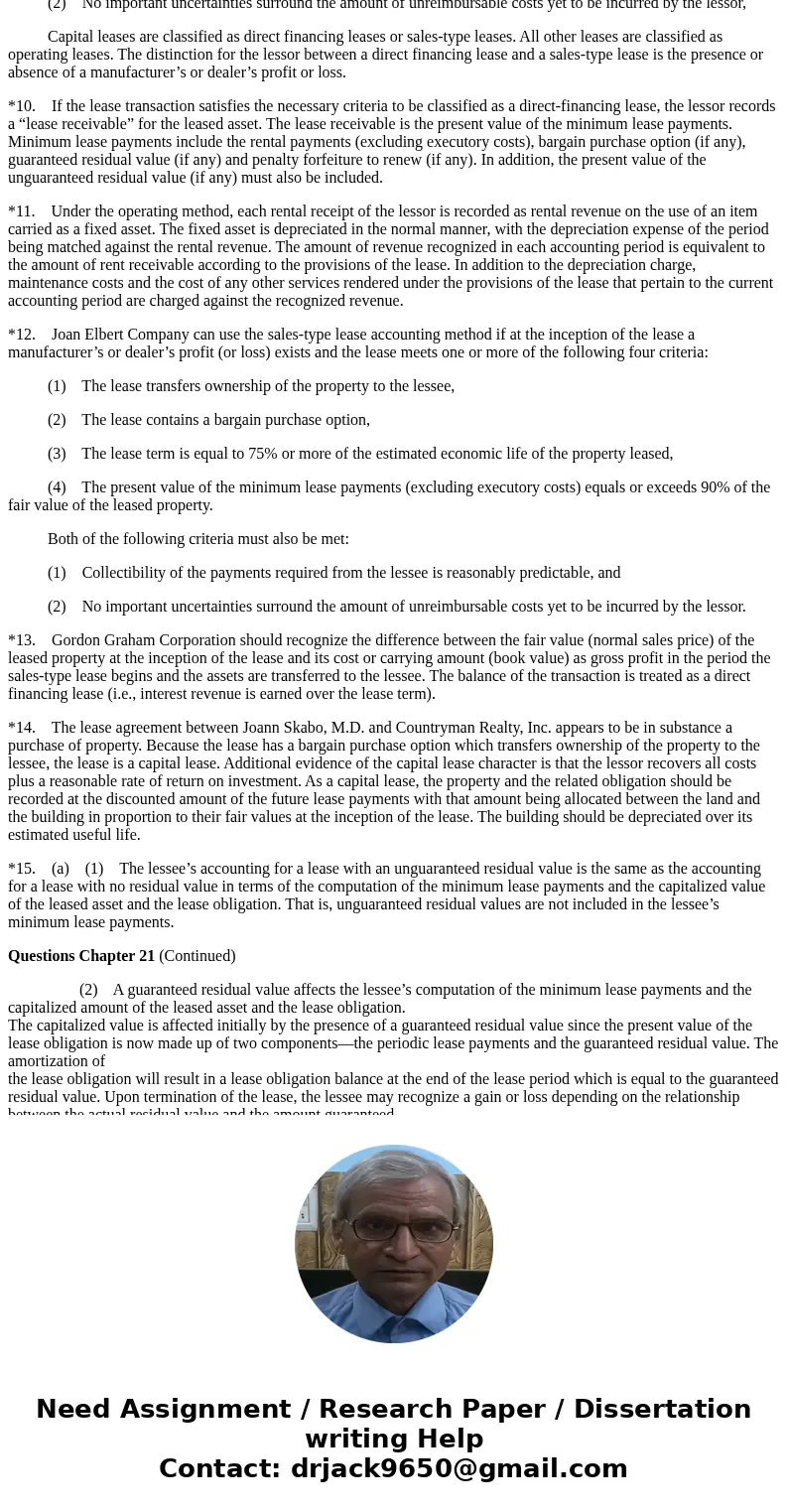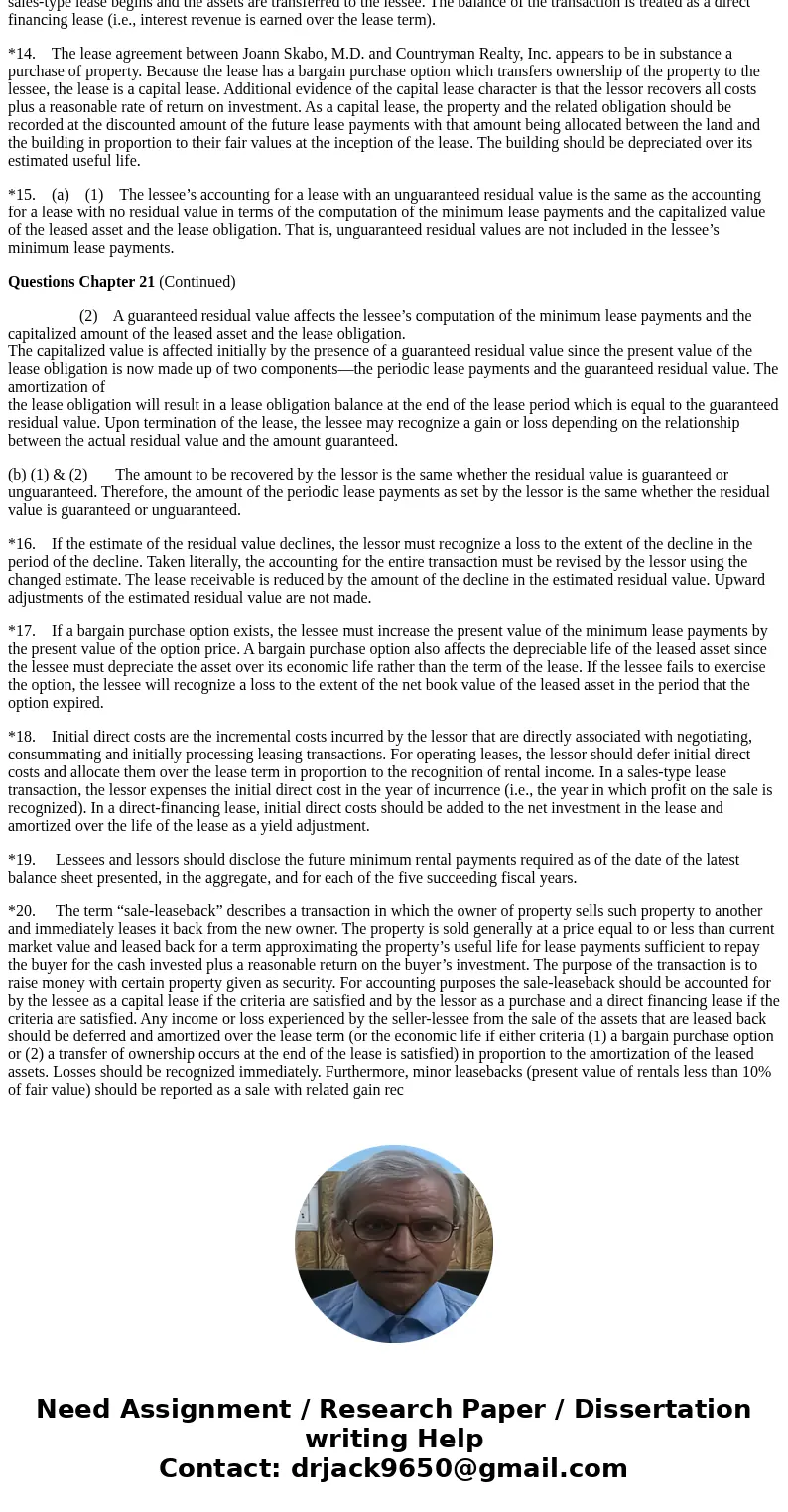Explain why a company like Southwest Airlines would prefer t
Explain why a company like Southwest Airlines would prefer to classify their long-term leases as operating leases or capital leases. Give the pros and cons of each from an accounting standpoint.
Solution
Wayne Higley Company’s rental of warehousing space on a short-term and sporadic basis is seldom construed as the acquisition of an asset or even a financing arrangement. The contract consists mainly of services which are to be performed proportionately by the lessor and the lessee—the rent to be paid by the lessee is offset by the service to be performed by the lessor. While a case can be made for the existence of an acquisition of some property rights, be they ever so trifling, the accounting treatment would be to record only the periodic rental payments as they are made and to allocate rent expense to the periods in which the benefits are received. No asset would be capitalized in this case, and an obligation for lease payments would be recorded only to the extent that services received from the lessor exceeded the rentals paid; that is, the rent payment is overdue. This lease should be reported as an operating lease.
**5. Minimum rental payments are the periodic payments made by the lessee and received by the lessor. These payments may include executory costs such as maintenance, taxes, and insurance. Minimum lease payments are payments required or expected to be made by the lessee. They include minimum rental payments less executory costs, a bargain purchase option, a guaranteed residual value, and a penalty for failure to renew the lease. The present value of the minimum lease payments is capitalized by the lessee.
**6. The distinction between a direct financing lease and a sales-type lease is the presence or absence of a manufacturer’s or dealer’s profit. A sales-type lease involves a manufacturer’s or dealer’s profit, and a direct financing lease does not. The profit is the difference between the fair value of the leased property at the inception of the lease and the lessor’s cost or carrying value.
**7. Under the operating method, a rent expense (and a compensating liability) accrues day by day to the lessee as the property is used. The lessee assigns rent to the periods benefiting from the use of the asset and ignores in the accounting any commitments to make future payments. Appropriate accruals are made if the accounting period ends between cash payment dates.
**8. Under the capital-lease method, the lessee treats the lease transactions as if the asset were being purchased on an installment basis: a financial transaction in which an asset is acquired and an obligation is created. The asset and the obligation are stated in the lessee’s balance sheet at the lower of: (1) the present value of the minimum lease payments (excluding executory costs) during the lease term or (2) the fair market value of the leased asset at the inception of the lease. The present value of the lease payments is computed using the lessee’s incremental borrowing rate unless the implicit rate used by the lessor is lower and the lessee has knowledge of it. The effective-interest method is used to allocate each lease payment between a reduction of the lease obligation and interest expense.
If the lease transfers ownership or contains a bargain purchase option, the asset is depreciated in a manner consistent with the lessee’s normal depreciation policy on assets owned, using the economic life of the asset and allowing for salvage value. If the lease does not transfer ownership or contain a bargain purchase option, the leased asset is amortized over the lease term.
**9. From the standpoint of the lessor, leases may be classified for accounting purposes as: (a) operating leases, (b) direct financing leases, and (c) sales-type leases.
From the standpoint of lessors, leases that meet one or more of the following four criteria:
(1) The lease transfers ownership,
(2) The lease contains a bargain purchase option,
(3) The lease term is equal to 75% or more of the estimated economic life of the property,
(4) The present value of the minimum lease payments (excluding executory costs) equals or exceeds 90% of the fair value of the property,
and meet both of the following criteria:
(1) Collectibility of the payments required from the lessee is reasonably predictable, and
Questions Chapter 21 (Continued)
(2) No important uncertainties surround the amount of unreimbursable costs yet to be incurred by the lessor,
Capital leases are classified as direct financing leases or sales-type leases. All other leases are classified as operating leases. The distinction for the lessor between a direct financing lease and a sales-type lease is the presence or absence of a manufacturer’s or dealer’s profit or loss.
*10. If the lease transaction satisfies the necessary criteria to be classified as a direct-financing lease, the lessor records a “lease receivable” for the leased asset. The lease receivable is the present value of the minimum lease payments. Minimum lease payments include the rental payments (excluding executory costs), bargain purchase option (if any), guaranteed residual value (if any) and penalty forfeiture to renew (if any). In addition, the present value of the unguaranteed residual value (if any) must also be included.
*11. Under the operating method, each rental receipt of the lessor is recorded as rental revenue on the use of an item carried as a fixed asset. The fixed asset is depreciated in the normal manner, with the depreciation expense of the period being matched against the rental revenue. The amount of revenue recognized in each accounting period is equivalent to the amount of rent receivable according to the provisions of the lease. In addition to the depreciation charge, maintenance costs and the cost of any other services rendered under the provisions of the lease that pertain to the current accounting period are charged against the recognized revenue.
*12. Joan Elbert Company can use the sales-type lease accounting method if at the inception of the lease a manufacturer’s or dealer’s profit (or loss) exists and the lease meets one or more of the following four criteria:
(1) The lease transfers ownership of the property to the lessee,
(2) The lease contains a bargain purchase option,
(3) The lease term is equal to 75% or more of the estimated economic life of the property leased,
(4) The present value of the minimum lease payments (excluding executory costs) equals or exceeds 90% of the fair value of the leased property.
Both of the following criteria must also be met:
(1) Collectibility of the payments required from the lessee is reasonably predictable, and
(2) No important uncertainties surround the amount of unreimbursable costs yet to be incurred by the lessor.
*13. Gordon Graham Corporation should recognize the difference between the fair value (normal sales price) of the leased property at the inception of the lease and its cost or carrying amount (book value) as gross profit in the period the sales-type lease begins and the assets are transferred to the lessee. The balance of the transaction is treated as a direct financing lease (i.e., interest revenue is earned over the lease term).
*14. The lease agreement between Joann Skabo, M.D. and Countryman Realty, Inc. appears to be in substance a purchase of property. Because the lease has a bargain purchase option which transfers ownership of the property to the lessee, the lease is a capital lease. Additional evidence of the capital lease character is that the lessor recovers all costs plus a reasonable rate of return on investment. As a capital lease, the property and the related obligation should be recorded at the discounted amount of the future lease payments with that amount being allocated between the land and the building in proportion to their fair values at the inception of the lease. The building should be depreciated over its estimated useful life.
*15. (a) (1) The lessee’s accounting for a lease with an unguaranteed residual value is the same as the accounting for a lease with no residual value in terms of the computation of the minimum lease payments and the capitalized value of the leased asset and the lease obligation. That is, unguaranteed residual values are not included in the lessee’s minimum lease payments.
Questions Chapter 21 (Continued)
(2) A guaranteed residual value affects the lessee’s computation of the minimum lease payments and the capitalized amount of the leased asset and the lease obligation.
The capitalized value is affected initially by the presence of a guaranteed residual value since the present value of the lease obligation is now made up of two components—the periodic lease payments and the guaranteed residual value. The amortization of
the lease obligation will result in a lease obligation balance at the end of the lease period which is equal to the guaranteed residual value. Upon termination of the lease, the lessee may recognize a gain or loss depending on the relationship between the actual residual value and the amount guaranteed.
(b) (1) & (2) The amount to be recovered by the lessor is the same whether the residual value is guaranteed or unguaranteed. Therefore, the amount of the periodic lease payments as set by the lessor is the same whether the residual value is guaranteed or unguaranteed.
*16. If the estimate of the residual value declines, the lessor must recognize a loss to the extent of the decline in the period of the decline. Taken literally, the accounting for the entire transaction must be revised by the lessor using the changed estimate. The lease receivable is reduced by the amount of the decline in the estimated residual value. Upward adjustments of the estimated residual value are not made.
*17. If a bargain purchase option exists, the lessee must increase the present value of the minimum lease payments by the present value of the option price. A bargain purchase option also affects the depreciable life of the leased asset since the lessee must depreciate the asset over its economic life rather than the term of the lease. If the lessee fails to exercise the option, the lessee will recognize a loss to the extent of the net book value of the leased asset in the period that the option expired.
*18. Initial direct costs are the incremental costs incurred by the lessor that are directly associated with negotiating, consummating and initially processing leasing transactions. For operating leases, the lessor should defer initial direct costs and allocate them over the lease term in proportion to the recognition of rental income. In a sales-type lease transaction, the lessor expenses the initial direct cost in the year of incurrence (i.e., the year in which profit on the sale is recognized). In a direct-financing lease, initial direct costs should be added to the net investment in the lease and amortized over the life of the lease as a yield adjustment.
*19. Lessees and lessors should disclose the future minimum rental payments required as of the date of the latest balance sheet presented, in the aggregate, and for each of the five succeeding fiscal years.
*20. The term “sale-leaseback” describes a transaction in which the owner of property sells such property to another and immediately leases it back from the new owner. The property is sold generally at a price equal to or less than current market value and leased back for a term approximating the property’s useful life for lease payments sufficient to repay the buyer for the cash invested plus a reasonable return on the buyer’s investment. The purpose of the transaction is to raise money with certain property given as security. For accounting purposes the sale-leaseback should be accounted for by the lessee as a capital lease if the criteria are satisfied and by the lessor as a purchase and a direct financing lease if the criteria are satisfied. Any income or loss experienced by the seller-lessee from the sale of the assets that are leased back should be deferred and amortized over the lease term (or the economic life if either criteria (1) a bargain purchase option or (2) a transfer of ownership occurs at the end of the lease is satisfied) in proportion to the amortization of the leased assets. Losses should be recognized immediately. Furthermore, minor leasebacks (present value of rentals less than 10% of fair value) should be reported as a sale with related gain rec



 Homework Sourse
Homework Sourse